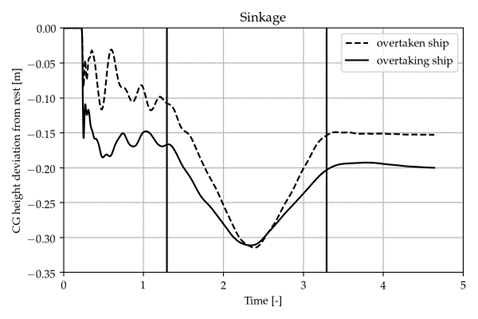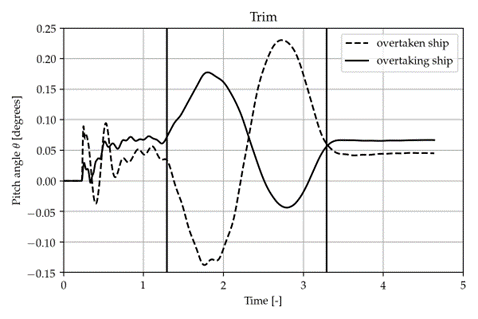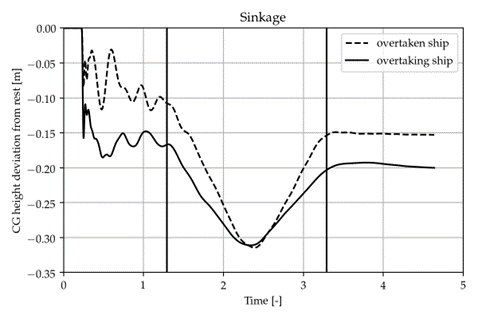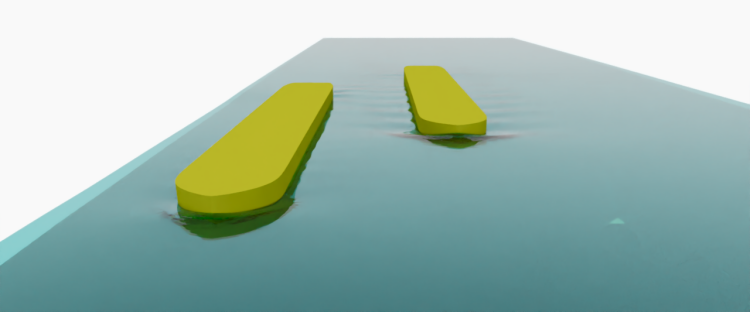June 2023, no. 136
News
BlueWeek
AI Sail
TopTier
CFD
Zero Emission
Foil Design
Traffic studies
F-series
Manxman ferry
Cover
Rendering of an overtaking manoeuvre simulated with ReFRESCO.
Create a MARIN account to stay updated
Report

In 2019 Rijkswaterstaat, part of the Dutch Ministry of Infrastructure and Water Management, and MARIN joined forces to investigate inland ship manoeuvring based on actual situations found on Dutch waterways.
With input provided by the government, MARIN investigated the influence of typical occurrences such as irregular riverbanks and uneven riverbeds [1] on the ship’s manoeuvrability in shallow water conditions. In 2022, the scope was extended to include the complex ship-ship interaction during an overtaking manoeuvre or a head-on passage [2]. In addition to numerical results, real-life measurements were also obtained as part of the investigation [3]. Further numerical work entailed simulation sweeps of (combined) yaw and drift configurations to obtain hull loads that in turn serve as input for fast-time models [4] that are developed by MARIN.


Modelling using ReFRESCO
The complexity of the physics involved in these situations does not allow for a great deal of simplification in modelling. MARIN’s proprietary Computational Fluid Dynamics (CFD) software ReFRESCO was therefore used for the numerical simulations, combining its demonstrated hydrodynamic accuracy and its versatility in delicate mesh deformation, which is required to accommodate the ship’s motion in shallow water.
Over the course of the investigation, the complicated mesh deformation has been a bottleneck in virtually all simulations performed, and it is the main reason the computations are relatively expensive. With continuous effort, however, significant improvements have been made to ReFRESCO to accelerate shallow water calculations, exemplifying the shared benefits of the collaboration.

Calibration of fast-time models
The output of the CFD simulations contains vast amounts of data on both the ship motion, as well as on the transient hydrodynamic loads acting on the hull during the manoeuvre. These results are directly used within MARIN for the subsequent calibration of fast-time models, while enabling Rijkswaterstaat to assess safety measures and regulations (such as speed limitations and vessel loading restrictions) around the locations where such situations occur. An example of the yield of ReFRESCO’s output is the squat of two inland vessels during a simulated overtaking manoeuvre shown in the figure. The local increase in sinkage as well as the mirrored trim behaviour of both ships are directly monitored by ReFRESCO and the numerical findings correspond well with real-life measurements.
Besides interesting insights, the collaboration on the topic of inland ship manoeuvring with Rijkswaterstaat, which formally ended in 2022 and is due to be renewed this year, has led to an increased level of confidence in ReFRESCO’s applicability for shallow water simulations. MARIN is very much looking forward to continuing our contribution to the subject of shallow water manoeuvring using our state-of-the-art CFD techniques.


Computed squat during a typical overtaking manoeuvre of two inland ships: sinkage (above) and trim (below) of both vessels. The vertical lines indicate the bow-stern alignments during the passage.
References
[1] ‘CFD investigation into sailing over an irregular riverbed’, MARIN Report 30957-12-RD
[2] ‘CFD calculations 2022; Squat in complex situations with ReFRESCO’, MARIN Report 30957-19-RD
[3] ‘Squat metingen in Amsterdam-Rijnkanaal aan boord van de Shalimar’, MARIN Report 30957-16-PAS
[4] ‘Manoeuvring mathematical model 2021’, MARIN Report 30957-13-MAN
More info:

CFD investigation of the effect of water depth on manoeuvring forces on inland ships







References
[1] ‘CFD investigation into sailing over an irregular riverbed’, MARIN Report 30957-12-RD
[2] ‘CFD calculations 2022; Squat in complex situations with ReFRESCO’, MARIN Report 30957-19-RD
[3] ‘Squat metingen in Amsterdam-Rijnkanaal aan boord van de Shalimar’, MARIN Report 30957-16-PAS
[4] ‘Manoeuvring mathematical model 2021’, MARIN Report 30957-13-MAN
Computed squat during a typical overtaking manoeuvre of two inland ships: sinkage (above) and trim (below) of both vessels. The vertical lines indicate the bow-stern alignments during the passage.


Calibration of fast-time models
The output of the CFD simulations contains vast amounts of data on both the ship motion, as well as on the transient hydrodynamic loads acting on the hull during the manoeuvre. These results are directly used within MARIN for the subsequent calibration of fast-time models, while enabling Rijkswaterstaat to assess safety measures and regulations (such as speed limitations and vessel loading restrictions) around the locations where such situations occur. An example of the yield of ReFRESCO’s output is the squat of two inland vessels during a simulated overtaking manoeuvre shown in the figure. The local increase in sinkage as well as the mirrored trim behaviour of both ships are directly monitored by ReFRESCO and the numerical findings correspond well with real-life measurements.
Besides interesting insights, the collaboration on the topic of inland ship manoeuvring with Rijkswaterstaat, which formally ended in 2022 and is due to be renewed this year, has led to an increased level of confidence in ReFRESCO’s applicability for shallow water simulations. MARIN is very much looking forward to continuing our contribution to the subject of shallow water manoeuvring using our state-of-the-art CFD techniques.
Rendering of an overtaking manoeuvre simulated with ReFRESCO.

Modelling using ReFRESCO
The complexity of the physics involved in these situations does not allow for a great deal of simplification in modelling. MARIN’s proprietary Computational Fluid Dynamics (CFD) software ReFRESCO was therefore used for the numerical simulations, combining its demonstrated hydrodynamic accuracy and its versatility in delicate mesh deformation, which is required to accommodate the ship’s motion in shallow water.
Over the course of the investigation, the complicated mesh deformation has been a bottleneck in virtually all simulations performed, and it is the main reason the computations are relatively expensive. With continuous effort, however, significant improvements have been made to ReFRESCO to accelerate shallow water calculations, exemplifying the shared benefits of the collaboration.
Report
June 2023, no. 136







More info:

With input provided by the government, MARIN investigated the influence of typical occurrences such as irregular riverbanks and uneven riverbeds [1] on the ship’s manoeuvrability in shallow water conditions. In 2022, the scope was extended to include the complex ship-ship interaction during an overtaking manoeuvre or a head-on passage [2]. In addition to numerical results, real-life measurements were also obtained as part of the investigation [3]. Further numerical work entailed simulation sweeps of (combined) yaw and drift configurations to obtain hull loads that in turn serve as input for fast-time models [4] that are developed by MARIN.
In 2019 Rijkswaterstaat, part of the Dutch Ministry of Infrastructure and Water Management, and MARIN joined forces to investigate inland ship manoeuvring based on actual situations found on Dutch waterways.





